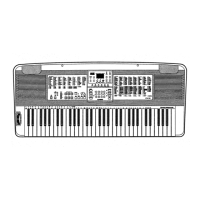
Do you have a question about the Casio CTK-750 and is the answer not in the manual?
| Number of Keys | 61 |
|---|---|
| Rhythms | 100 |
| Display | LCD |
| MIDI | Yes |
| Transpose | Yes |
| Tuning | Yes |
| Metronome | Yes |
| Pedal Input | Yes |
| USB | No |
| Touch Response | Yes |
| Dimensions | 131 mm |
| Effects | Reverb |
Details the available power sources for the keyboard.
Instructions for correctly inserting batteries into the unit.
Step-by-step guide to turn the keyboard on and off.
How to select and play different instrument sounds.
Learn to use the automatic accompaniment feature.
Learn to use the one-finger chord system for accompaniment.
Understand how to play standard fingerings for accompaniment.
Features for recording, playback, and managing songs.
Instructions on how to record musical performances into memory.
Understand the 3-digit display and its various indicators.
Learn about the different operational modes of the keyboard.
Steps to enable or disable touch sensitivity.
Overview of the 16 available digital effects.
Guide on how to choose and apply digital effects.
How to choose and start built-in rhythm patterns.
Explanation of the dedicated section for playing chords.
Simplified chord playing method using one finger.
Understand how to play standard fingerings for accompaniment.
Understanding how to control part volumes, panning, and effects.
Assigning two different tones to different keyboard sections.
Combining two tones to play simultaneously with a single key press.
Control over parameters for split/layered tones.
Customizing the functions assigned to the sound pads.
Customizing which rhythm plays for intros, fills, and endings.
Selecting special preset performance functions.
Steps to initiate a Free Session chord progression.
Adjusting the tone while using Magical Presets.
Saving current settings for quick recall.
Assigning functions to the pedal jack.
Information on the storage limits for recorded songs.
Creating the initial recording of a song.
Guide on how to add multiple tracks to a song.
Overview of the mixer's functions and display.
Adjusting mixer settings for individual tracks.
Instructions for listening to recorded songs.
Process for removing individual tracks from recorded songs.
Capabilities for sending MIDI data from the keyboard.
Capabilities for receiving MIDI data to the keyboard.
Configuring the primary MIDI channel for communication.
Controls volume balance for specific MIDI channels.
Controls volume balance for specific MIDI channels.
Enabling or disabling General MIDI features.
Activating or deactivating local control.
Defining the amount of pitch change from the pitch bend wheel.
Performing the bulk data sending operation.
Loading data from an external MIDI device.
Assigning specific tones to incoming MIDI channels.
Fine-tuning the keyboard's pitch.
Changing the keyboard's key signature.